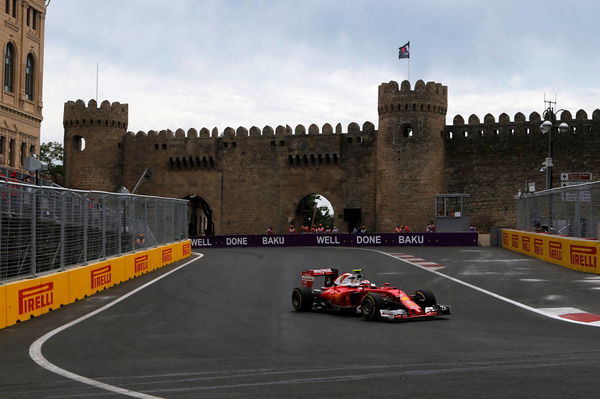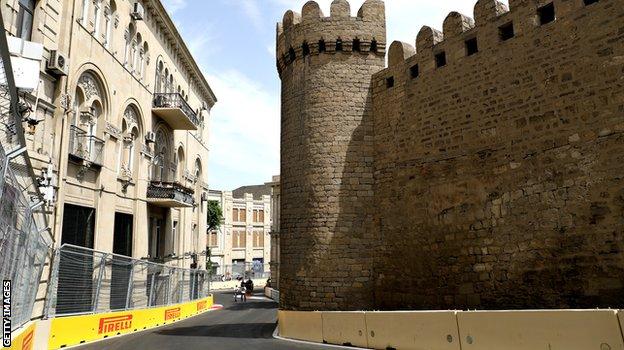

As they say, never judge a book by its cover; Baku City Circuit, is the newest addition to the calendar and runs under the prestigious title of the European Grand Prix. Circuits like Brands Hatch, Jerez, Donington Park, Nurburgring and it infamous Valencia Street Circuit have all played host to the European Grand Prix and are all remembered for the historic races that have taken place over the years. After Valenica’s absence since 2012, the prestige of the European Grand Prix has been bestowed over to Azerbaijan.
It is designed by the now well-known Hermann-Tilke, but it is far from being a “Tilke-drome”.

via Imago
Credits: espnf1.com
Months earlier, the promoters and the FIA released the circuit design and to be honest, we at ES felt a little underwhelmed. It was a bunch of 90 degree corners separated by medium length straights during the first bit (T1,2,3,4,5,6,7..) and then, the circuit went into the a tighter technical section which opened up into a high speed series of corners and then onto the start finish straight which goes on for miles.
To the old school fans of Spa, Suzuka, Silverstone, us including, the circuit felt like it lacked the flow necessary to be a great track.
However, after seeing the cars and drivers in action on the track yesterday, we at ES feel like a lot of those opinions and observations have to be changed.
The circuit feels like it has a character of its own. It’s resemblance to Macau, Singapore, Monaco and even Monza, to be honest, has surprised me personally.
Navigating through the track :
ADVERTISEMENT
Article continues below this ad
ADVERTISEMENT
Article continues below this ad
The start finish straight is very long and combine that with the full throttle sections of T17,18,19,20 and you have yourself, a roughly 2.5 km long stretch of pure speed.This would also play host to the first of the two DRS zones. The cars will hit around 350-360 kmph before they brake hard into the first 90 degree corner, T1. Here, drag is key to a good lap. The lower the drag the lower the resistance, but to have that lower drag configuration, a lower downforce setup is required. You can’t have one without the other. Hence we expect, Williams and Force India and even Manor to do well on this part of the circuit. Any car with a Mercedes Power Unit in the back is honestly going to be mighty here.
Braking for T1 is quite tricky as finding the right braking point at 350 kmph is a challenge in itself. There is ample run off to give the drivers who make a mistake, a bit of a get-out-of-jail-free card. T1’s exit is quite wide, which then sets you up for a tighter T2.
T2 and T3 have quite a long straight in between them, equivalent to Hungary’s main straight. This is the second DRS zone for the track.
T3 has a tricky braking as the circuit tightens up on entry as well as exit. The run of area is pretty limited, so if you make a mistake, expect the drivers to engage the Reverse gear or do a pirouette really gently.
T4 is relatively straight forward, low speed right hander which leads into T5.
T5 is tricky because it can be so deceptive. Anything you carry in T5 will always have an effect at T6 as combined, they form a kind of chicane. Having driven the track on a simulator, we can speculate that, T5 requires more slowing down than you might think at first.
T6 is a traction corner, the back end can get very loose here. This leads us onto a medium length straight which then leads into the old part of the city
T7 is where the Macau resemblance starts to kick in, with next to no run-off area, the circuit gets really very tight on exit and mounting the kerb can unsettle the car so you have to thread the needle here. Slow and easy does it.

via Imago
The narrow part of the circuit. Credits: bbc
T8,9,10 are what we call the Jewel of Baku. The circuit here is only 7.5 m wide with a castle wall as an apex for turn 9. Someone is bound to lose his car here. It is so tight on entry and exit but relatively slower than people expected. Recovery of crashed cars may cause a Red Flag situation but it is fascinating to watch how the cars navigate.
T11, 12 are almost a mirror image of T5,6 but 11 is a little longer which makes managing that right pedal even more critical. This brings us to the first high speed corner sequence of the track.
T13,14 is a very fast left hander with the wall on the exit a sign of pending doom for some drivers. It’s easy flat. This section requires the high downforce package, which is in contrast to the low downforce setup required for the first part and mechanical grip being key to the second part of the track.
T15 is what appears to be catching most drivers out. Here, you can really observe the track’s elevation changes, and the corner being relatively low speed, can make or break an entire lap. The trick here is to trail brake a bit and then roll the car using the right foot, as the exit is just a barrier waiting for the invite to wreck your car. A lot of cars found trouble making the corner stick and had to use the again limited run-off area.
The track swoops down into Turn 16 which is crucial as it sets you up for the final sequence of full throttle corners. The exit kerb caused a lot of corner-exit oversteer for some cars which could be crucial come raceday as this would compromise their speed down the main straight.
Now the track opens into T17,18,19,20, which really are just kinks along the way, should be easy flat for most cars and round up back to the finish line.
ADVERTISEMENT
Article continues below this ad
Baku, is a real driver’s track which is somewhat like a high speed version of Monaco in reference to the closeness of walls. It rewards the brave but bites back when not respected. Overall, the circuit is a definite challenge to master with a tricky pit lane entry and exit. With so many straights, it would be slipstreaming festival, come Sunday.
ADVERTISEMENT
ADVERTISEMENT
ADVERTISEMENT
ADVERTISEMENT

